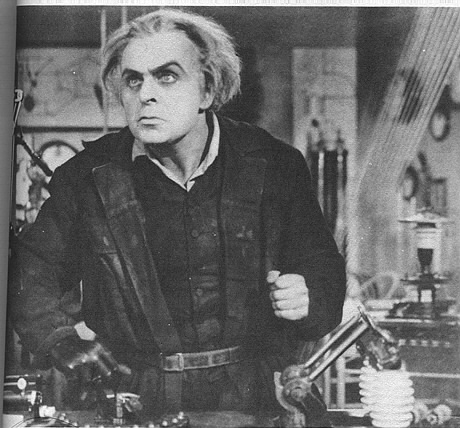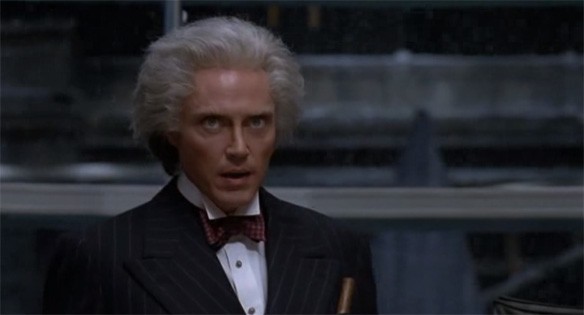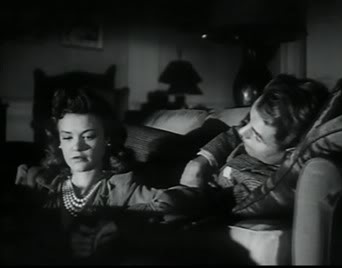We've already looked at the references to the comics in Batman Returns, but now we look to everything else – films, music, architecture, literature, history, real life people and events, etc.
The opening shot of the movie pays homage to the opening scene from Orson Welles' Citizen Kane (1941). In both movies, we open on an exterior shot of a foreboding mansion at night. In the foreground we see a gate adorned with the family initial. 
We then angle in on a solitary illuminated window in the otherwise darkened mansion. But where Welles' movie opens with a death, Burton's begins with a birth.
Throughout the following scenes we never see the monstrous child, echoing Roman Polanski's approach to the demonic infant in Rosemary's Baby (1968). In both movies we just see the child's cradle/pram and are left to infer their appearance based on the horrified reaction of their parents.
The scene of Oswald's abandonment is the first of several Biblical allusions to the Book of Exodus. Just as Moses' parents sent him down the Nile in a basket, so Oswald's parents place his baby carriage into the river in Gotham Park. But where Moses' parents were trying to save their son's life, Oswald's are trying to kill him.
The design and lighting during the title sequence evoke the famous Viennese sewers from Carol Reed's The Third Man (1949). The look of Gotham City in this film was heavily influenced by the neo-fascist architecture of the early twentieth century. The works of Albert Speer proved very influential on the production design, as did the designs of American architect Hugh Ferriss.
The look of Gotham City in this film was heavily influenced by the neo-fascist architecture of the early twentieth century. The works of Albert Speer proved very influential on the production design, as did the designs of American architect Hugh Ferriss.
Gotham Plaza was inspired by New York City's Rockefeller Centre.
The art deco statues were likewise inspired by those in the Rockefeller Centre.
The Christmas carol 'God Rest Ye Merry Gentlemen' can be heard in the background during the first scene in Gotham Plaza. 'We Wish You a Merry Christmas' is played shortly afterwards when the Ice Princess switches on the Christmas tree lights.
The overhead shot of the Shreck building is a nod to the iconic shot of the Tower of Babel from Fritz Lang's seminal expressionist film Metropolis (1927). Art director Tom Duffield has said the interior decor of the Shreck building was also influenced by Metropolis.
The Shreck Industries logo is a grinning cat's head; a possible reference to the Cheshire Cat from Lewis Carroll's Alice's Adventures in Wonderland (1865).
Quote
"Please, would you tell me," said Alice, a little timidly, for she was not quite sure whether it was good manners for her to speak first, "why your cat grins like that?"
"It's a Cheshire cat," said the Duchess, "and that's why. Pig!"
She said the last word with such sudden violence that Alice quite jumped; but she saw in another moment that it was addressed to the baby, and not to her, so she took courage, and went on again: -
"I didn't know that Cheshire cats always grinned; in fact, I didn't know that cats could grin."
"They all can," said the Duchess; "and most of 'em do."
(Chapter 6)
The character of Max Shreck was named after the German actor of the same name, most famous for his portrayal of Count Orlok in F. W. Murnau's expressionist horror film Nosferatu (1922).
Max Shreck's hairstyle may have been influenced by C.A. Rotwang (The Inventor) in the silent film Metropolis (1927).


The photos on the wall in Shreck's office show Max posing with several famous people. It's hard to tell, but you can see Sammy Davis Jr, George Bush Sr, Elvis Presley, Richard Nixon and Arnold Schwarzenegger! Could this could be the earliest appearance of Victor Fries in the movie series?
The shots of the Penguin's shadow are typical of the expressionist films produced in Weimar Germany.
The music during the attack on the tree lighting ceremony includes a quotation from 'Making Christmas', one of the songs Danny Elfman wrote for Tim Burton's The Nightmare Before Christmas (1993).
One of the gang members sets fire to a toy display in a shop. Amongst the immolated toys can be seen some Teenage Mutant Ninja Turtles merchandise. 
Batman's costume has an art deco look, partially inspired by the angular musculature of the Oscar statuette given out at the Academy Awards.
The Penguin's subterranean lair was perhaps inspired by the Erik's hideout beneath the Paris Opera House in Gaston Leroux's The Phantom of the Opera (1911).
Danny DeVito has cited Lawrence Oliver's performance in Richard III (1955) as an influence on his portrayal of Cobblepot. The Penguin's story in this film has many thematic parallels with Richard's story in William Shakespeare's play: namely those of deformity, infanticide, power politics, and Richard's jealousy of his privileged sibling (in the original script, Shreck was to be revealed as Oswald's brother). The Penguin's makeup effects are also somewhat similar to those used in the 1955 film version of Richard III.
Another prominent influence on the depiction of the Penguin, and the film as a whole, was Robert Wiene's The Cabinet of Dr. Caligari (1920). Similarities between Caligari and the Penguin can be seen in their makeup and costume designs, as well as the waddling gait with which they both walk. Both Caligari and the Penguin arrive in town as part of a circus sideshow. During the daytime they present an upstanding facade to the townsfolk, but at night send out their sideshow lackeys to do their evil bidding. 

One of the headstones wobbles slightly as the Penguin brushes past it during the graveyard scene. On the surface this would appear to be a goof. But some viewers have speculated it may be a deliberate homage to Ed Wood's Plan 9 From Outer Space (1959), in which the fake cardboard gravestones were constantly wobbling and falling over whenever the actors walked past.
During her first fight scene, Catwoman carves a 3x3 grid onto the face of a rapist, saying "tic-tac-toe" as she does so. Obviously this is a reference to the game tic-tac-toe (or noughts & crosses, for those of us in the UK).
Shreck's line about going "fifteen rounds with Muhammad Shreck" is an allusion to world heavyweight boxing champion Muhammad Ali.
When Shreck tries to persuade Cobblepot to stand for election, he mentions Nixon as an example of how an elected official can be removed from office. This refers to President Richard Nixon's resignation in 1974 following the Watergate scandal.
When discussing how they might recall the current mayor, Shreck mentions the Gulf of Tonkin and Reichstag fire incidents as templates for their own strategy. The Reichstag fire refers to the arson attack on the Reichstag Building in Berlin in 1933. The Gulf of Tonkin incident refers to a naval engagement between the US and North Vietnam in 1964. Both of these examples show political parties capitalising upon violent events as a pretext for action. Shreck and Cobbleplot adopt the same approach in the movie, sending out the Red Triangle Gang members to terrorise the city and undermine the citizens' faith in their elected officials.The fight choreography during the ensuing riot scene evokes the gang fights from Walter Hill's The Warriors (1979); a movie which fight choreographer Dave Lea had studied a few years previous when developing his own fighting style centred around the use of baseball bats. The appearance of the Red Triangle Gang members evoke some of the more colourful gangs from The Warriors. Most notably the Hi-Hats and the Baseball Furies.
During the fight, Batman draws a blade from the mouth of a sword swallower and uses it as a weapon. Roger Moore's James Bond did the same thing during a fight scene in Octopussy (1983).
The rooftop fight between Batman and Catwoman visually recalls the opening chase sequence from Alfred Hitchcock's Vertigo (1958), a movie that was heavily referenced in the previous Batman film.


During his date with Selina, Bruce mentions Norman Bates and Ted Bundy. Norman Bates was the reclusive serial killer from Alfred Hitchcock's Psycho (1960). Ted Bundy was a real life serial killer responsible for the deaths of over thirty people.
The psychosexual dynamic of the Selina Kyle/Catwoman character in this movie is reminiscent of Irena Dubrovna (Simone Simon) in Jacques Tourneur's Cat People (1942). Irena was a repressed woman who transformed into a deadly panther upon becoming sexually aroused. Tourneur avoided showing too much of the panther throughout the film, instead using sounds and shadows to suggest its presence. Note how in this particular shot the shadow of the chair in the background forms a cat shadow behind Irena. It looks like the shadow Selina casts when wearing her cowl.

The love scene in Batman Returns is similar to a scene in Tourneur's film where Irena and her boyfriend are resting on a couch in front of a roaring fire. Her boyfriend Oliver (Kent Smith) tries to kiss her, but Irena draws away from him, frightened of the power she might unleash if she allows herself to become aroused.

 Batman Returns features several scenes of bats viciously attacking people en masse. These scenes, as well as the general theme of birds (in this case penguins) attacking humans, are reminiscent of Alfred Hitchcock's The Birds (1963).
Batman Returns features several scenes of bats viciously attacking people en masse. These scenes, as well as the general theme of birds (in this case penguins) attacking humans, are reminiscent of Alfred Hitchcock's The Birds (1963).
The death of the Ice Princess is perhaps another scene influenced by Vertigo (1958). In both films, a man and woman conspire against the hero by taking a captive woman to the top of a high building. There the male villain sends the captive woman plummeting to her death while the hero watches, powerless to save her. In both movies the female co-conspirator is horrified by the male villain's murderous act. And in both films the hero is blamed for the woman's death.

The entrance to the Batcave is disguised as an iron maiden. This is possibly a nod to two of Tim Burton's favourite films: Mario Bava's Black Sunday (1960) and Roger Corman's The Pit and the Pendulum (1961), both of which feature scenes where characters played by Barbara Steele are pierced by a spiked mask/iron maiden. Burton would later revisit the iron maiden motif in Sleepy Hollow (1999).
Once Cobblepot's true nature has been exposed he is chased out of the city by the police. This scene recalls Caligari's flight from the authorities when they discover he is responsible for the murders in The Cabinet of Dr. Caligari (1920).
Cobblepot's line "I am not a human being! I am an animal!" is an inversion of John Merrick's (John Hurt) famous line from David Lynch's The Elephant Man (1980): "I am not an animal! I am a human being!"
Cobblepot's plan to exact revenge against the people of Gotham by murdering their firstborn sons is another Biblical reference to the Book of Exodus.
The piece of music playing when Bruce arrives at Shreck's masquerade is an instrumental version of Rick James' 1981 song 'Super Freak'. This song had undergone a revival in popularity prior to Batman Returns' release after M. C. Hammer sampled it in 'You Can't Touch This' (1990).
During the party a guest is seen standing on the staircase dressed as the Red Death from Edgar Allan Poe's 'Masque of the Red Death' (1842). This is a reference to the Bal Masqué scene from The Phantom of the Opera (1925), where Lon Chaney appears on the staircase dressed as the Red Death. Danny Elfman has cited Russian composer Sergei Prokofiev as one of his main inspirations, and the latter's influence is clearly audible throughout this film's score. Note the similarities between Prokofiev's 'Battle on the Ice' from Sergei Eisenstein's Alexander Nevsky (1938) and Elfman's 'The Final Confrontation'.
Danny Elfman has cited Russian composer Sergei Prokofiev as one of his main inspirations, and the latter's influence is clearly audible throughout this film's score. Note the similarities between Prokofiev's 'Battle on the Ice' from Sergei Eisenstein's Alexander Nevsky (1938) and Elfman's 'The Final Confrontation'.













by Silver Nemesis
by Silver Nemesis
by Silver Nemesis
by The Joker
by The Joker
by The Joker
by The Joker
by The Dark Knight
by Silver Nemesis
by The Dark Knight